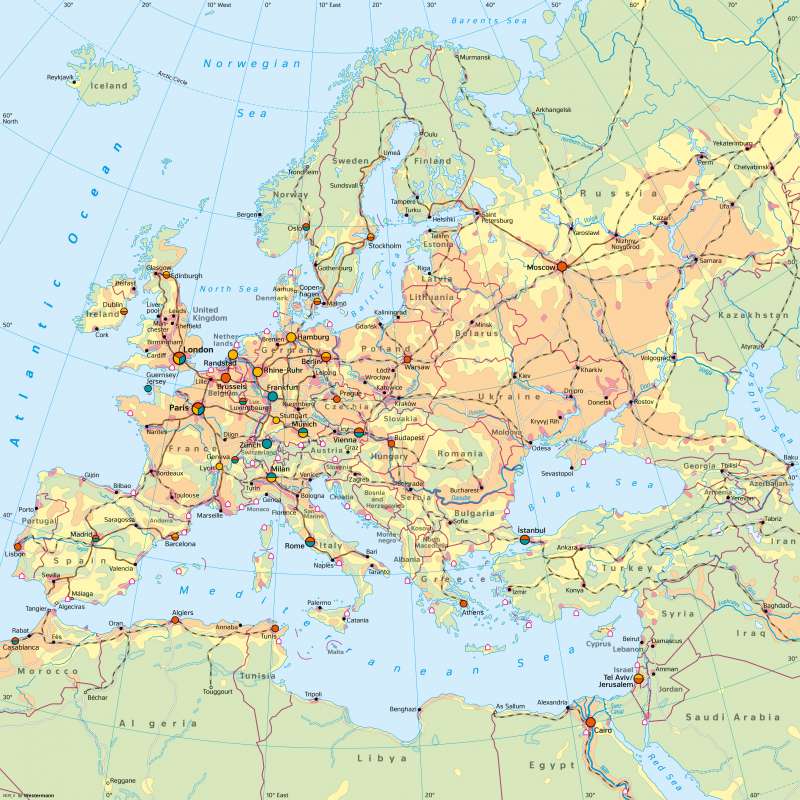Europe - Economy today
Economy
978-3-14-100890-6 | Page 64 | Ill. 3

Overview
In the European economic region, very different types of space can be distinguished. The last near-natural landscapes that are little used economically include the tundras of northern Europe, northern Scotland, some mountain ranges of the Alps and Carpathians, as well as some scattered regions in southern Europe on the Iberian Peninsula, in southern France and in the southern Balkans.
Distribution of economic areas in Europe
Interrupted only by the English Channel and the Alps, a strip of high density economic use stretches from central and southern England via the Benelux region along the Rhine through Switzerland to northern Italy. This economic area, for which the term "blue banana" (Roger Brunet, 1989) has become common, has extensions across the Paris region to Brittany (Nantes), the Rhône valley (Lyon), Munich and along the Central Uplands to Upper Silesia. Other areas of high density are the Spanish, French and Italian Mediterranean coasts, various coastal locations in Northern Europe such as Copenhagen, Oslo or St. Petersburg, and some selective locations, mainly around the capitals of Southern and Eastern Europe (for example: Lisbon, Madrid, Athens, Istanbul, Budapest). Within Ukraine and Russia, the Donetsk Basin, Moscow, and its surrounding areas, as well as the Ural region are important densely populated areas, between which, however, there are very large distances in contrast to Western and Central Europe.
The largest area is taken up by landscapes that are neither close to nature nor highly densified, but which, as man-made cultivated land, have a variety of economic and agricultural uses. Large parts of Western, Southern and Eastern Europe, but also large areas in Northern, Central and Eastern Germany belong to this type of economic area.
Germany belongs to the countries with a polycentric spatial structure, in which different economic centres each have their own focus. In contrast, countries such as France, Denmark or Hungary have a monocentric spatial structure, in which the capital region has a predominant economic and political importance over all other national regions.
Transport and tourism
Europe's major economic centres are linked by a modern and efficient infrastructure. The greatest variety of transport modes and the greatest density of motorway and rail networks are found in the densely populated core area of the EU. Starting from there, a well-developed high-speed rail network has emerged in recent years. In peripheral regions, traffic is usually limited to a few routes, and the transport network is more extensive.
An important component of transport connections are the large ports, for example in Rotterdam, Hamburg and London, which act as hubs for the international trade in goods. No less important are major airports such as those in London, Paris, Frankfurt, Amsterdam, or Madrid. The Öresund region around Copenhagen and Malmö provides a good example of how innovation and economic growth are creating new development corridors that influence the whole region.
Outside the economic centres, there are some important tourism regions, which, apart from the Alpine region, are almost exclusively located on the coasts (cf. maps 70/71).
Traditional industrial areas
In the early days of industrialisation, heavy industries settled near important mining areas because of their need for raw materials. Traditional industrial areas include the areas of central England, northern France and Belgium, which were formerly based on coal, the Ruhr region, the Halle-Leipzig industrial area, Upper Silesia and the Saarland-Lorraine-Lux mining triangle ("Saar-Lor-Lux"). Heavy industry had developed in these areas at an early stage. However, with the onset of the coal and steel crisis around 1960, a deep crisis developed in Central and Western Europe, which led to a reduction of jobs.
Some of these regions have been able to set new economic priorities in the course of structural change. Brussels and Luxembourg, for example, have gained a new significance as political and cultural centres or financial centres through the settlement of EU authorities and financial institutions. The Ruhr region, which lost about 500,000 jobs in the manufacturing sector between 1980 and 2000 alone, has developed into an innovation centre with over 80 percent of employment in the service sector. The main focus there today is on energy, environmental, information and communication technology, as well as trade and logistics in particular. In other old industrial centres, the transition to the post-industrial phase has not been as successful despite positive approaches to date, for example in Liverpool, which is still suffering from the decline of the industrial sector, while the transformation in nearby Manchester, the economically strongest English city after London, has been relatively successful.
Global, continental and national centres
According to the degree of their spatial impact, the European economic centres have a different importance in the global hierarchy. Only London and Paris are true global cities, metropolises of global importance. Characteristics of a global city are the concentration of globally active companies, its function as an international financial centre, the concentration of knowledge-intensive services, its seat of international political institutions and actors, and its function as a global transport hub.
Economic centres of continental importance are, on the one hand, some capital cities such as Berlin, Brussels, Vienna, Rome, and Moscow, but also highly dense economic areas such as Randstad in the Netherlands and the Rhine-Ruhr region or international financial centres such as Frankfurt and Zurich. Most of the major economic centres are concentrated in the economic heart of Europe, while there are only three cities of international importance on the Iberian Peninsula (Lisbon, Madrid, Barcelona) and only cities of national importance in the economically less developed Balkan region.
The economic centres also differ in terms of their orientation and sectoral structure. It can be seen that the innovation and financial centres are mainly concentrated in the core area, while they are only seldomly present on the outer edges. In economically less developed North Africa, they are completely absent. The few cities with international appeal are mainly political and cultural centres with a less diversified economic structure.




